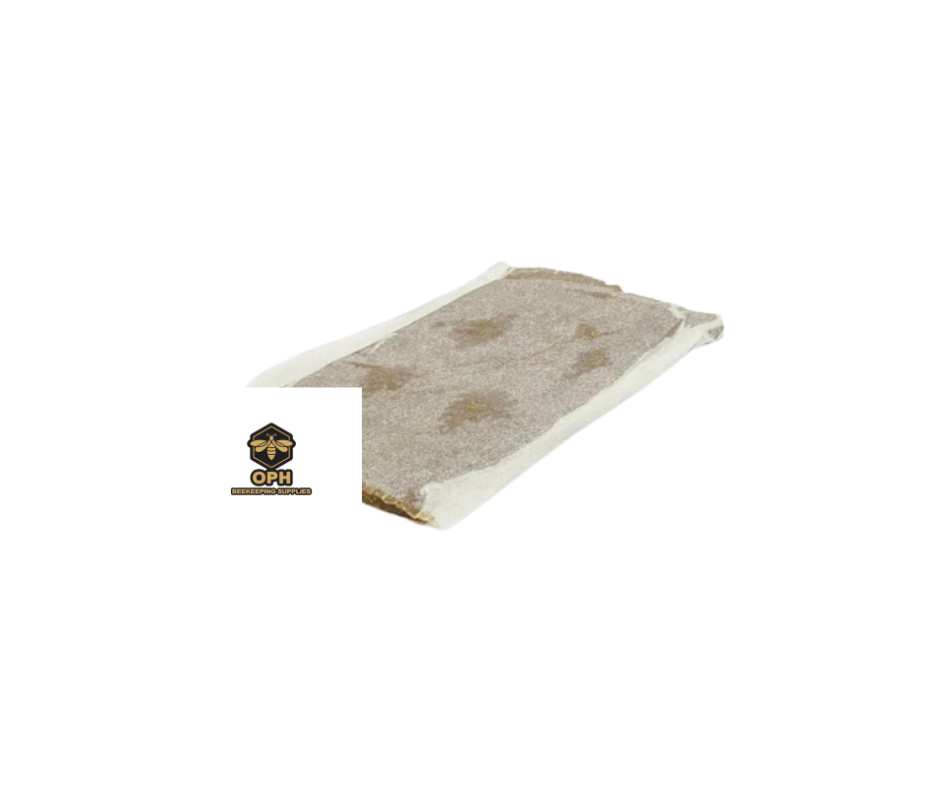
Pollen Patties: Understanding Pollen Patties , Their Benefits, Uses and Best Practices in Beekeeping
Share
Understanding Pollen Patties: Benefits, Uses, and Best Practices in Beekeeping
Introduction
Pollen patties are an essential nutritional supplement for honeybee colonies, providing a rich source of protein and essential nutrients. These patties are widely used in beekeeping to support colony health, boost brood production, and sustain bees during periods of pollen scarcity. This article explores the composition, benefits, application methods, and best practices for using pollen patties in beekeeping.
What Are Pollen Patties?
Pollen patties are soft, dough-like supplements made from pollen or pollen substitutes mixed with sugar syrup, soybean flour, brewer’s yeast, or other protein-rich ingredients. They are designed to provide honeybees with essential nutrients when natural pollen sources are unavailable or insufficient.
Key Ingredients in Pollen Patties
- Natural Pollen: Provides essential amino acids and nutrients.
- Pollen Substitutes: Often include soy flour, yeast, or egg powder.
- Sugar Syrup or Honey: Helps bind ingredients together and serves as an energy source.
- Essential Nutrients: Some patties contain additional vitamins and minerals to enhance bee health.
Benefits of Pollen Patties
Using pollen patties in a beekeeping operation offers numerous benefits:
1. Boosting Brood Rearing
Pollen is vital for the development of young bees. Providing pollen patties in early spring or late winter ensures that nurse bees have enough protein to feed larvae, leading to stronger colonies.
2. Supporting Colonies During Dearth Periods
During periods of low pollen availability, such as late summer or early fall, pollen patties provide a crucial protein source to maintain colony health.
3. Preventing Malnutrition and Weak Colonies
Lack of protein can lead to malnourished bees, weak colonies, and reduced resistance to diseases. Pollen patties help prevent nutritional deficiencies.
4. Enhancing Hive Productivity
Healthy, well-fed colonies produce more honey, pollinate crops more effectively, and have higher survival rates.
5. Boosting Queen Egg Laying
Providing a high-protein diet encourages the queen to lay more eggs, ensuring a robust workforce within the colony.
When to Use Pollen Patties
Pollen patties should be used strategically based on seasonal needs and colony conditions.
1. Early Spring
- Encourages colony buildup before nectar flow.
- Supports brood rearing when natural pollen is scarce.
2. Late Summer to Early Fall
- Prepares colonies for winter by ensuring they have enough young bees.
- Strengthens colonies after honey harvest.
3. Winter Feeding
- Provides protein to overwintering colonies in cold climates.
- Should be used in combination with carbohydrate supplements (sugar syrup or fondant).
4. During Pollen Shortages
- Useful in areas with limited floral diversity or periods of drought.
How to Feed Pollen Patties
Proper application of pollen patties ensures bees can easily access them while minimizing waste and pest issues.
Placement of Pollen Patties
- Lay the patty directly on top of the frames, near the brood chamber.
- Ensure it is accessible to bees but does not block hive ventilation.
Quantity and Frequency
- Feed one patty per colony (about ½ to 1 pound) and monitor consumption.
- Replace when depleted, typically every 7–10 days.
Avoiding Overfeeding
- Overfeeding pollen patties can lead to excessive brood rearing and increased Varroa mite infestations.
- Monitor colony response and adjust feeding accordingly.
Risks and Considerations
1. Attracting Pests and Pests
- Ants, small hive beetles, and wax moths are attracted to pollen patties.
- Remove uneaten portions to prevent infestations.
2. Risk of Disease Transmission
- Use high-quality, pathogen-free ingredients.
- Avoid using patties from unknown sources to prevent contamination.
3. Influence on Swarming Behavior
- Excessive brood rearing may increase swarming tendencies in spring.
- Balance pollen patty feeding with hive space management.
DIY Pollen Patty Recipe
Beekeepers can make their own pollen patties using simple ingredients.
Ingredients:
- 2 cups soy flour or brewer’s yeast
- 1 cup natural pollen (if available)
- 2 cups sugar syrup (1:1 ratio water to sugar)
- 1 teaspoon vegetable oil (optional for texture)
Instructions:
- Mix dry ingredients in a bowl.
- Slowly add sugar syrup while stirring until a dough-like consistency forms.
- Shape into patties and wrap in wax paper or plastic for storage.
- Place directly on hive frames for bees to consume.
Conclusion
Pollen patties are an invaluable tool for beekeepers, providing essential protein to support colony growth, brood production, and overall hive health. When used appropriately, they help strengthen bee populations and enhance honey production. By understanding the best practices for feeding pollen patties, beekeepers can ensure their colonies remain strong, resilient, and productive throughout the year.
